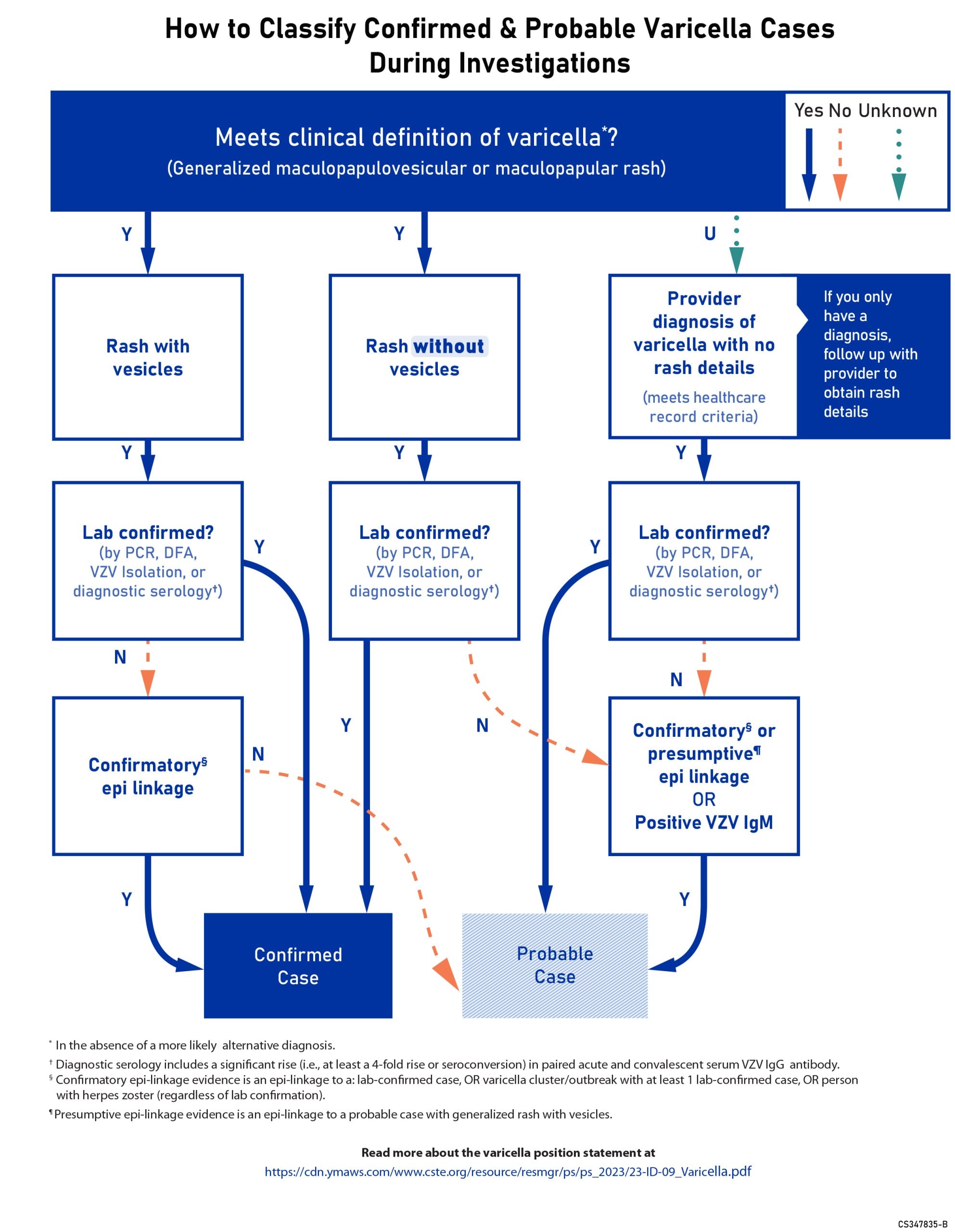About
During varicella investigations, health departments can download and use this flowchart to see how to classify confirmed and probable cases. Follow steps outlined in three classification scenarios. These steps are based on the 2024 varicella case definition.
Text equivalent
How to Classify Confirmed & Probable Varicella Cases During Investigations
Does the case meet the clinical definition of varicella in the absence of a more likely alternative diagnosis? This means the case has a generalized maculopapulovesicular rash or maculopapular rash.
A) If yes and there is a rash with vesicles
- First ask if the varicella case has been lab-confirmed by PCR, DFA, VZV isolation, or diagnostic serology.
- Diagnostic serology includes a significant rise (i.e., at least a 4-fold rise or seroconversion) in paired acute and convalescent serum VZV IgG antibody.
- Diagnostic serology includes a significant rise (i.e., at least a 4-fold rise or seroconversion) in paired acute and convalescent serum VZV IgG antibody.
- If the case has been lab-confirmed, then classify as confirmed case.
- If the case is NOT lab-confirmed, then ask if case had a confirmatory epi linkage to a: lab-confirmed case, OR varicella cluster/outbreak with at least 1 lab-confirmed case, OR person with herpes zoster (regardless of lab confirmation).
- If case had a confirmatory epi linkage, then classify as confirmed case.
- If case had NO confirmatory epi linkage, then classify as probable case.
B) If yes and there is a rash without vesicles
- First ask if the varicella case has been lab-confirmed by PCR, DFA, VZV isolation, or diagnostic serology.
- Diagnostic serology includes a significant rise (i.e., at least a 4-fold rise or seroconversion) in paired acute and convalescent serum VZV IgG antibody.
- Diagnostic serology includes a significant rise (i.e., at least a 4-fold rise or seroconversion) in paired acute and convalescent serum VZV IgG antibody.
- If the case has been lab-confirmed, then classify as confirmed case.
- If the case is NOT lab-confirmed, then classify as probable case, only if it meets 1 of the following criteria:
- Has confirmatory epi linkage to a: lab-confirmed case, OR varicella cluster/outbreak with at least 1 lab-confirmed case, OR person with herpes zoster (regardless of lab confirmation).
- Has presumptive epi linkage to a: probable case with generalized rash with vesicles.
- Has a positive VZV IgM.
- Has confirmatory epi linkage to a: lab-confirmed case, OR varicella cluster/outbreak with at least 1 lab-confirmed case, OR person with herpes zoster (regardless of lab confirmation).
C) If clinical definition of varicella is unknown
If you have a case with a provider diagnosis but with no rash details, this means the case meets the healthcare record criteria.
- Follow up with the provider to obtain rash details if you only have a diagnosis.
- Ask if the varicella case has been lab-confirmed by PCR, DFA, VZV isolation, or diagnostic serology.
- If the case has been lab-confirmed, then classify as confirmed case.
- If the case is NOT lab-confirmed, then classify as probable case, only if it meets 1 of the following criteria:
- Has confirmatory epi linkage to a: lab-confirmed case, OR varicella cluster/outbreak with at least 1 lab-confirmed case, OR person with herpes zoster (regardless of lab confirmation).
- Has presumptive epi linkage to a: probable case with generalized rash with vesicles.
- Has a positive VZV IgM.
- Has confirmatory epi linkage to a: lab-confirmed case, OR varicella cluster/outbreak with at least 1 lab-confirmed case, OR person with herpes zoster (regardless of lab confirmation).
Read more about the varicella position statement at: https://cdn.ymaws.com/www.cste.org/resource/resmgr/ps/ps_2023/23-ID-09_Varicella.pdf

